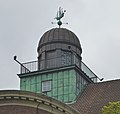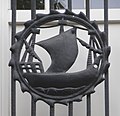Lloyd train station
The former Lloyd train station in Bremen - Findorff is at the north exit of Bremen main train station at the corner of Gustav-Deetjen-Allee 2-6 and Theodor-Heuss-Allee 2. The building is a listed building .
building
The Lloyd station was built in 1913 according to plans by the architect Rudolf Jacobs . City architect Adolf Muesmann had pushed for a set-back development with a “courtyard of honor”, which turned into a forecourt open to the Parkviertel. The main building is axially aligned with Hohenlohestrasse. On the left, towards the railroad tracks, is the two-storey side wing.
The mighty, neo-baroque , two-storey administration building with its clinker brick facades from the turn of the century has a distinctive, five-axis entrance portico , above it a large, round gable field with the coat of arms of North German Lloyd , showing the Bremen key and an anchor. The design was based on buildings from the 17th / 18th centuries. Century in the Netherlands. It was intended to establish a regional building tradition through other Jacobs buildings in Bremen such as the Staatliche Kunstgewerbeschule and Postamt 5. On the hipped roof is the round, open ridge tower with copper cladding and a maritime weather vane . In the center of the main building was the waiting room, which stretched over two floors.
use
The client was the then largest German shipping company , Norddeutsche Lloyd (NDL) in Bremen, with around 60 passenger and combined ships at the time. The Lloyd station served as a baggage department and emigration station for the ship's passengers, who were then brought to Bremerhaven to travel from Kaiserhafen II / III with the Lloyd steamers mainly to America and mostly emigrated. From the Lloyd station, the travelers got through the now closed, narrow Lloyd tunnel to the platforms of the main station.
The house was only able to perform this function for a good year until 1914 when overseas shipping came to a standstill due to the First World War . Only after the overseas passenger traffic could be resumed by Lloyd from 1922, the Lloyd station received more attention in this function. In 1927, with the completion of the Columbuskaje in Bremerhaven and the soon following station by the sea , the direct rail connection to the hinterland came and the Lloyd station again lost its original importance. Next to the Lloyd building from 1910, the Lloyd's headquarters in Bremen, it became the shipping company's second administrative headquarters. From 1941 the building was used by the Gestapo as a collection point for deportation transports. Over 780 Jewish fellow citizens were deported from here to Minsk and Theresienstadt. After the Second World War , the damaged Lloyd building was taken over by the State of Bremen and the shipping company's headquarters were now in the former Lloyd train station. In 1970, after the merger of North German Lloyd with HAPAG of the same size to form the major shipping company Hapag-Lloyd , the location in Bremen became the shipping company's second headquarters.
Today various companies are located in the administrative wing, including a. Hapag-Lloyd AG, Hapag-Lloyd travel agency and other travel companies and service providers. The demolition of an auxiliary building made it possible to build a hotel on Theodor-Heuss-Allee at the north entrance of Bremen main station, which uses the representative parts of the Lloyd station.
Monument protection
In 2001, the building was listed as a cultural monument in Bremen .
Literature, sources
- Chamber of Architects Bremen, BDA Bremen and Senator for Environmental Protection and Urban Development (ed.): Architecture in Bremen and Bremerhaven , Example 55. Worpsweder Verlag, Bremen 1988, ISBN 3-922516-56-4 .
- Der Baumeister 1914, No. 14 pp. 57–64, plates 107–113, supplement to issue 14, pp. 257 B – 269 B, here: pp. 62–63.
Web links
Individual evidence
- ↑ Stolpersteine initiative .
- ^ Project for traces of the association "Remembering for the Future" on July 9, 2019.
- ↑ Monument database of the LfD Bremen
Coordinates: 53 ° 5 ′ 1.3 " N , 8 ° 48 ′ 56.6" E



